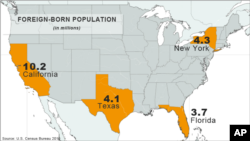The U.S. Census Bureau released data on Thursday showing that America's foreign-born population has risen to an all-time high of 40 million. The data also shows that people who have come to live in the U.S. tend to reside in larger households with more children and grandparents, compared to native households.
The Census Bureau defines a "foreign born" as a person living in the United States who was not an American citizen at birth, regardless of whether the individual is now a citizen or legal resident.
Elizabeth Grieco, head of the bureau's Foreign-Born Population Branch, said the total number has grown from just under 10 million in 1970 to a record 40 million two years ago. "Now while the number of foreign born in 2010 does represent a historical high, the proportion of the total population was lower than during the great migration wave of the late 1800s and early 1900s, when the proportion fluctuated between 13 and 15 percent," she said.
She said most of the increase was in the early part of the decade, before 2006.
The data in the report comes from the 2010 American Community Survey. It is a set of questions posed yearly to a sampling of the population. And it goes into much more detail than the nationwide decennial census.
The report found that foreign-born households on average had more children and grandparents, and Grieco said they were not as likely to be led by a single parent. "A higher proportion of foreign born than native-born households were maintained by a married couple," she said.
The data also showed that the fertility rate among foreign women was 35 percent higher than among native-born women.
Foreign-born households earned on average a little more than $46,000 a year, compared to just over $50,000 for native households.
And Grieco said that while foreign-born residents live in every state, more than half are concentrated in just four states: California, New York, Texas and Florida.








